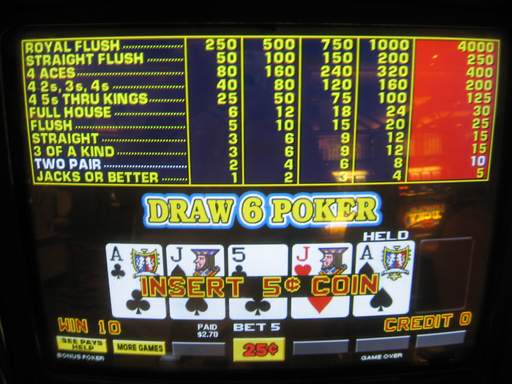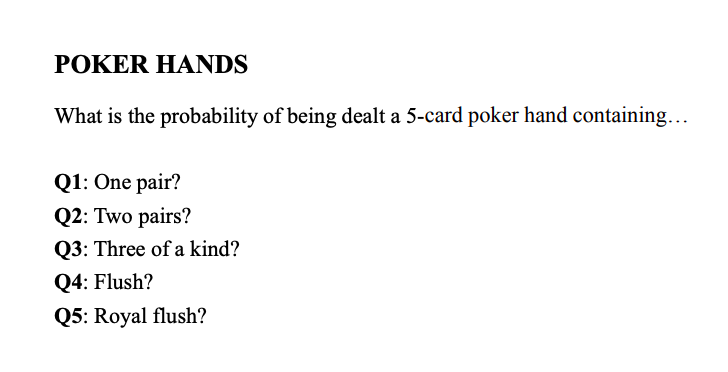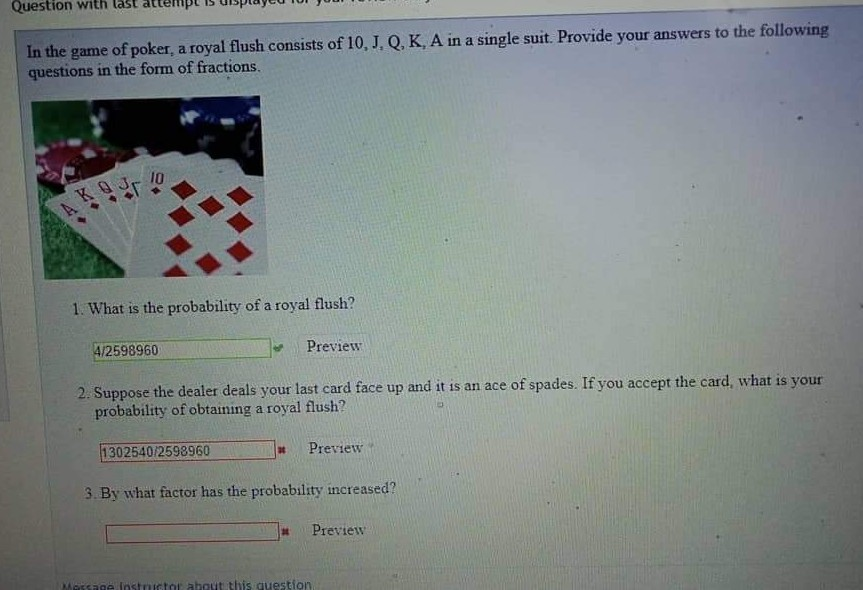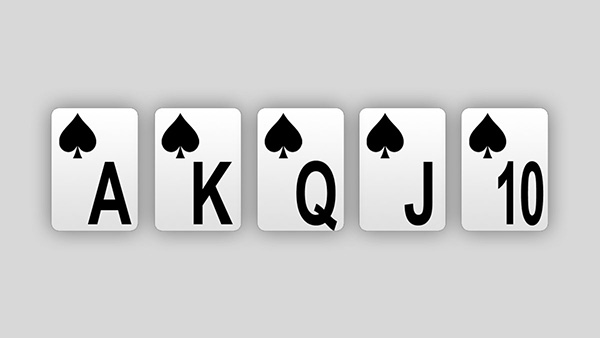Poker Probability Royal Flush
for various wild card specifications
Including a “Pai Gow” (“Bug”) Joker
- Note that the probability of getting one when you are dealt your pocket cards is way lower than the probability of getting one after the board is complete, that is of course because you won’t go to the river on every hand.
- The probability is the fraction of the 2,598,960 hands that meet the requirement of the type of hands in question. Note that royal flush is not listed. This is because it is included in the count for straight flush. Royal flush is omitted so that he counts add up to 2,598,960. Probabilities of Poker Hands.
- Royal Flush dealt: 1 / 650,000: Royal Flush ending hand: 1 / 40,000: Four of a kind: 1 / 423: Four Aces: 1 / 5,761: Four Aces with a kicker: 1 / 16,236: Four Deuces.
A “poker hand” consists of 5 unordered cards from a standard deck of 52. There are 52 5 = 2,598,9604 possible poker hands. Below, we calculate the probability of each of the standard kinds of poker hands. This hand consists of values 10,J,Q,K,A, all of the same suit. Since the values are fixed, we only need to choose the suit. The probability of being dealt a royal flush is the number of royal flushes divided by the total number of poker hands. We now carry out the division and see that a royal flush is rare indeed. There is only a probability of 4/2,598,960 = 1/649,740 = 0.00015% of being dealt this hand.
The tables below show the probabilities of being dealt various poker hands with different wild card specifications. Each Poker hand consists of selecting the 5 best cards from a random 7 card deal.
While probabilities for the best 5 card hand from a deal of 7 cards (but no wild cards) can be calculated via direct combinatorics, the introduction of wild cards greatly complicates the combinatoric calculations. Thus, to produce the results shown here, the author wrote a computer program that would generate all possible poker hands. Each of these poker hands was evaluated for matched ranks (pairs, 3 of a kind, etc.), straights, and flushes. Wild cards introduce multiple evaluations for a given hand, and the best standard evaluation for any given hand is used in the tables.
Data from this page may be freely used provided it includes an acknowledgement to the author.
7 card poker probabilities if there are no wild cards
(Computer program and data by Bill Butler)
Poker Hand Nbr. of Hands Probability
----------------------------------------------------
5 of a kind 0 0.00000000
Royal straight flush 4,324 0.00003232
Other straight flush 37,260 0.00027851
4 of a kind 224,848 0.00168067
Full House 3,473,184 0.02596102
Flush 4,047,644 0.03025494
Ace high straight 747,980 0.00559093
Other straights 5,432,040 0.04060289
3 of a kind 6,461,620 0.04829870
2 pairs 31,433,400 0.23495536
One pair >= Jacks 18,188,280 0.13595201
One pair <= Tens 40,439,520 0.30227345
Ace high 12,944,820 0.09675870
King high 6,386,940 0.04774049
Queen high 2,719,500 0.02032746
Jack high 963,480 0.00720173
Ten high 248,640 0.00185851
Nine high 31,080 0.00023231
Subtotals high card only 23,294,460 0.17411920
Total = 133,784,560 1.00000000
= COMBIN(52,7)
(Interesting observation: If a hand evaluates to just one pair, it is not distributed 4/13 “Jacks or better”. If you have a single middle-sized pair, you have a slightly increased chance of also having a straight which evaluates to a better hand. Thus a middle-sized pair occurs slightly less often than a high (Jacks or better) or a low (5’s or lower) pair.)
7 card poker probabilities if one “Pai Gow” (“Bug”) Joker is added to the deck
A “Pai Gow” (“Bug”) Joker is partially wild. If you are using it to complete a straight and/or a flush, it is an ordinary wild card. If you are using it for pairs, 3-of-a-kind, etc., it is forced to be an Ace.
(Computer program and data by Bill Butler)
Poker Hand Nbr. of Hands Probability
----------------------------------------------------
5 Aces 1,128 0.00000732
Royal straight flush 26,132 0.00016953
Other straight flush 184,832 0.00119909
4 of a kind 307,472 0.00199472
Full House 4,188,528 0.02717299
Flush 6,172,088 0.04004129
Ace high straight 1,554,156 0.01008255
Other straights 9,681,872 0.06281094
3 of a kind 7,470,676 0.04846585
2 pairs 35,553,816 0.23065464
One pair >= Jacks 19,273,104 0.12503386
One pair <= Tens 44,948,856 0.29160476
Ace high 14,430,780 0.09361938
King high 6,386,940 0.04143514
Queen high 2,719,500 0.01764270
Jack high 963,480 0.00625056
Ten high 248,640 0.00161305
Nine high 31,080 0.00020163
Subtotals high card only 24,780,420 0.16076246
Total = 154,143,080 1.00000000
= COMBIN(53,7)
7 card poker probabilities if one ordinary Joker is added to the deck
(Computer program and data by Bill Butler)
Poker Hand Nbr. of Hands Probability
----------------------------------------------------
5 of a kind 14,664 0.00009513
Royal straight flush 26,132 0.00016953
Other straight flush 184,832 0.00119909
4 of a kind 1,121,024 0.00727262
Full House 5,997,144 0.03890635
Flush 6,027,224 0.03910149
Ace high straight 1,543,460 0.01001316
Other straights 9,540,480 0.06189366
3 of a kind 13,315,300 0.08638273
2 pairs 31,433,400 0.20392352
One pair >= Jacks 21,170,640 0.13734408
One pair <= Tens 40,474,320 0.26257630
Ace high 12,944,820 0.08397925
King high 6,386,940 0.04143514
Queen high 2,719,500 0.01764270
Jack high 963,480 0.00625056
Ten high 248,640 0.00161305
Nine high 31,080 0.00020163
Subtotals high card only 23,294,460 0.15112232
Total = 154,143,080 1.00000000
= COMBIN(53,7)

7 card poker probabilities if two Jokers are added to the deck
(Computer program and data by Bill Butler)
Poker Hand Nbr. of Hands Probability
----------------------------------------------------
5 of a kind 88,608 0.00050033
Royal straight flush 91,764 0.00051815
Other straight flush 548,196 0.00309539
4 of a kind 3,134,544 0.01769923
Full House 8,521,104 0.04811449
Flush 8,397,324 0.04741557
Ace high straight 2,531,540 0.01429436
Other straights 14,181,120 0.08007383
3 of a kind 20,216,380 0.11415198
2 pairs 31,433,400 0.17748899
One pair >= Jacks 24,153,000 0.13638014
One pair <= Tens 40,509,120 0.22873513
Ace high 12,944,820 0.07309305
King high 6,386,940 0.03606392
Queen high 2,719,500 0.01535568
Jack high 963,480 0.00544030
Ten high 248,640 0.00140395
Nine high 31,080 0.00017549
Subtotals high card only 23,294,460 0.13153239
Total = 177,100,560 1.00000000
= COMBIN(54,7)
7 card poker probabilities with One-eyed Jacks wild
(Computer program and data by Bill Butler)
Poker Hand Nbr. of Hands Probability
----------------------------------------------------
5 of a kind 75,072 0.00056114
Royal straight flush 54,508 0.00040743
Other straight flush 447,946 0.00334826
4 of a kind 2,552,718 0.01908081
Full House 6,733,344 0.05032975
Flush 6,388,172 0.04774970
Ace high straight 1,404,464 0.01049795
Other straights 11,201,130 0.08372513
3 of a kind 15,758,140 0.11778743
2 pairs 23,810,436 0.17797596
One pair >= Jacks 16,255,890 0.12150797
One pair <= Tens 32,047,590 0.23954625
Ace high 9,743,580 0.07283038
King high 4,662,000 0.03484707
Queen high 1,888,110 0.01411306
Jack high 481,740 0.00360086
Ten high 248,640 0.00185851
Nine high 31,080 0.00023231
Subtotals high card only 17,055,150 0.12748220
Total = 133,784,560 1.00000000
= COMBIN(52,7)
7 card poker probabilities with Deuces (2’s) wild
(Computer program and data by Bill Butler)
Poker Hand Nbr. of Hands Probability
----------------------------------------------------
5 of a kind 609,760 0.00455778
Royal straight flush 399,484 0.00298602
Other straight flush 1,552,732 0.01160621
4 of a kind 7,504,920 0.05609706
Full House 9,421,824 0.07042535
Flush 7,993,600 0.05974979
Ace high straight 4,033,160 0.03014668
Other straights 15,355,640 0.11477887
3 of a kind 20,151,920 0.15062964
2 pairs 19,491,840 0.14569574
One pair >= Jacks 16,211,160 0.12117362
One pair <= Tens 20,708,880 0.15479275
Ace high 6,386,940 0.04774049
King high 2,719,500 0.02032746
Queen high 963,480 0.00720173
Jack high 248,640 0.00185851
Ten high 31,080 0.00023231
Nine high 0 0.00000000
Subtotals high card only 10,349,640 0.07736050
Total = 133,784,560 1.00000000
= COMBIN(52,7)
7 card poker probabilities with 2 Jokers,
One-eyed Jacks, and Deuces (2’s) wild
(8 out of 54 cards are wild)
 (Computer program and data by Bill Butler)
(Computer program and data by Bill Butler)Poker Hand Nbr. of Hands Probability
----------------------------------------------------
5 of a kind 5,496,072 0.03103362
Royal straight flush 1,821,704 0.01028627
Other straight flush 6,959,976 0.03929957
4 of a kind 23,628,576 0.13341898
Full House 12,751,424 0.07200104
Flush 13,497,668 0.07621471
Ace high straight 6,037,238 0.03408932
Other straights 25,527,008 0.14413849
3 of a kind 28,206,968 0.15927091
2 pairs 14,381,496 0.08120525
One pair >= Jacks 15,378,900 0.08683711
One pair <= Tens 16,024,260 0.09048114
Ace high 4,693,080 0.02649952
King high 1,911,420 0.01079285
Queen high 629,370 0.00355374
Jack high 124,320 0.00070197
Ten high 31,080 0.00017549
Nine high 0 0.00000000
Subtotals high card only 7,389,270 0.04172358
Total = 177,100,560 1.00000000
= COMBIN(54,7)
Alsoplease see 5 card Poker probabilities
Alsoplease see 6 card Poker probabilities
 Alsoplease see 8 card, 9 card, and 10 card Poker probabilities
Alsoplease see 8 card, 9 card, and 10 card Poker probabilitiesReturn to the main Poker probabilities page
Return to Durango Bill’s home page
Web page generated via Sea Monkey's Composer HTML editor
within a Linux Cinnamon Mint 18 operating system.
(Goodbye Microsoft)
This post works with 5-card Poker hands drawn from a standard deck of 52 cards. The discussion is mostly mathematical, using the Poker hands to illustrate counting techniques and calculation of probabilities
Working with poker hands is an excellent way to illustrate the counting techniques covered previously in this blog – multiplication principle, permutation and combination (also covered here). There are 2,598,960 many possible 5-card Poker hands. Thus the probability of obtaining any one specific hand is 1 in 2,598,960 (roughly 1 in 2.6 million). The probability of obtaining a given type of hands (e.g. three of a kind) is the number of possible hands for that type over 2,598,960. Thus this is primarily a counting exercise.
___________________________________________________________________________
Preliminary Calculation
Usually the order in which the cards are dealt is not important (except in the case of stud poker). Thus the following three examples point to the same poker hand. The only difference is the order in which the cards are dealt.
These are the same hand. Order is not important.
The number of possible 5-card poker hands would then be the same as the number of 5-element subsets of 52 objects. The following is the total number of 5-card poker hands drawn from a standard deck of 52 cards.
The notation is called the binomial coefficient and is pronounced “n choose r”, which is identical to the number of -element subsets of a set with objects. Other notations for are , and . Many calculators have a function for . Of course the calculation can also be done by definition by first calculating factorials.
Thus the probability of obtaining a specific hand (say, 2, 6, 10, K, A, all diamond) would be 1 in 2,598,960. If 5 cards are randomly drawn, what is the probability of getting a 5-card hand consisting of all diamond cards? It is
This is definitely a very rare event (less than 0.05% chance of happening). The numerator 1,287 is the number of hands consisting of all diamond cards, which is obtained by the following calculation.

The reasoning for the above calculation is that to draw a 5-card hand consisting of all diamond, we are drawing 5 cards from the 13 diamond cards and drawing zero cards from the other 39 cards. Since (there is only one way to draw nothing), is the number of hands with all diamonds.
If 5 cards are randomly drawn, what is the probability of getting a 5-card hand consisting of cards in one suit? The probability of getting all 5 cards in another suit (say heart) would also be 1287/2598960. So we have the following derivation.
Thus getting a hand with all cards in one suit is 4 times more likely than getting one with all diamond, but is still a rare event (with about a 0.2% chance of happening). Some of the higher ranked poker hands are in one suit but with additional strict requirements. They will be further discussed below.
Another example. What is the probability of obtaining a hand that has 3 diamonds and 2 hearts? The answer is 22308/2598960 = 0.008583433. The number of “3 diamond, 2 heart” hands is calculated as follows:
One theme that emerges is that the multiplication principle is behind the numerator of a poker hand probability. For example, we can think of the process to get a 5-card hand with 3 diamonds and 2 hearts in three steps. The first is to draw 3 cards from the 13 diamond cards, the second is to draw 2 cards from the 13 heart cards, and the third is to draw zero from the remaining 26 cards. The third step can be omitted since the number of ways of choosing zero is 1. In any case, the number of possible ways to carry out that 2-step (or 3-step) process is to multiply all the possibilities together.
___________________________________________________________________________
The Poker Hands
Here’s a ranking chart of the Poker hands.
The chart lists the rankings with an example for each ranking. The examples are a good reminder of the definitions. The highest ranking of them all is the royal flush, which consists of 5 consecutive cards in one suit with the highest card being Ace. There is only one such hand in each suit. Thus the chance for getting a royal flush is 4 in 2,598,960.
Royal flush is a specific example of a straight flush, which consists of 5 consecutive cards in one suit. There are 10 such hands in one suit. So there are 40 hands for straight flush in total. A flush is a hand with 5 cards in the same suit but not in consecutive order (or not in sequence). Thus the requirement for flush is considerably more relaxed than a straight flush. A straight is like a straight flush in that the 5 cards are in sequence but the 5 cards in a straight are not of the same suit. For a more in depth discussion on Poker hands, see the Wikipedia entry on Poker hands.
The counting for some of these hands is done in the next section. The definition of the hands can be inferred from the above chart. For the sake of completeness, the following table lists out the definition.
Definitions of Poker Hands
| Poker Hand | Definition | |
|---|---|---|
| 1 | Royal Flush | A, K, Q, J, 10, all in the same suit |
| 2 | Straight Flush | Five consecutive cards, |
| all in the same suit | ||
| 3 | Four of a Kind | Four cards of the same rank, |
| one card of another rank | ||
| 4 | Full House | Three of a kind with a pair |
| 5 | Flush | Five cards of the same suit, |
| not in consecutive order | ||
| 6 | Straight | Five consecutive cards, |
| not of the same suit | ||
| 7 | Three of a Kind | Three cards of the same rank, |
| 2 cards of two other ranks | ||
| 8 | Two Pair | Two cards of the same rank, |
| two cards of another rank, | ||
| one card of a third rank | ||
| 9 | One Pair | Three cards of the same rank, |
| 3 cards of three other ranks | ||
| 10 | High Card | If no one has any of the above hands, |
| the player with the highest card wins |
___________________________________________________________________________
Poker Probability Royal Flush Solution
Counting Poker Hands
Straight Flush
Counting from A-K-Q-J-10, K-Q-J-10-9, Q-J-10-9-8, …, 6-5-4-3-2 to 5-4-3-2-A, there are 10 hands that are in sequence in a given suit. So there are 40 straight flush hands all together.
Four of a Kind
There is only one way to have a four of a kind for a given rank. The fifth card can be any one of the remaining 48 cards. Thus there are 48 possibilities of a four of a kind in one rank. Thus there are 13 x 48 = 624 many four of a kind in total.
Full House
Let’s fix two ranks, say 2 and 8. How many ways can we have three of 2 and two of 8? We are choosing 3 cards out of the four 2’s and choosing 2 cards out of the four 8’s. That would be = 4 x 6 = 24. But the two ranks can be other ranks too. How many ways can we pick two ranks out of 13? That would be 13 x 12 = 156. So the total number of possibilities for Full House is
Note that the multiplication principle is at work here. When we pick two ranks, the number of ways is 13 x 12 = 156. Why did we not use = 78?
Flush
There are = 1,287 possible hands with all cards in the same suit. Recall that there are only 10 straight flush on a given suit. Thus of all the 5-card hands with all cards in a given suit, there are 1,287-10 = 1,277 hands that are not straight flush. Thus the total number of flush hands is 4 x 1277 = 5,108.
Poker Probability Royal Flush Valves
Straight
There are 10 five-consecutive sequences in 13 cards (as shown in the explanation for straight flush in this section). In each such sequence, there are 4 choices for each card (one for each suit). Thus the number of 5-card hands with 5 cards in sequence is . Then we need to subtract the number of straight flushes (40) from this number. Thus the number of straight is 10240 – 10 = 10,200.
Three of a Kind
There are 13 ranks (from A, K, …, to 2). We choose one of them to have 3 cards in that rank and two other ranks to have one card in each of those ranks. The following derivation reflects all the choosing in this process.
Two Pair and One Pair
These two are left as exercises.
High Card
The count is the complement that makes up 2,598,960.
The following table gives the counts of all the poker hands. The probability is the fraction of the 2,598,960 hands that meet the requirement of the type of hands in question. Note that royal flush is not listed. This is because it is included in the count for straight flush. Royal flush is omitted so that he counts add up to 2,598,960.

Probabilities of Poker Hands
| Poker Hand | Count | Probability | |
|---|---|---|---|
| 2 | Straight Flush | 40 | 0.0000154 |
| 3 | Four of a Kind | 624 | 0.0002401 |
| 4 | Full House | 3,744 | 0.0014406 |
| 5 | Flush | 5,108 | 0.0019654 |
| 6 | Straight | 10,200 | 0.0039246 |
| 7 | Three of a Kind | 54,912 | 0.0211285 |
| 8 | Two Pair | 123,552 | 0.0475390 |
| 9 | One Pair | 1,098,240 | 0.4225690 |
| 10 | High Card | 1,302,540 | 0.5011774 |
| Total | 2,598,960 | 1.0000000 |
___________________________________________________________________________
2017 – Dan Ma